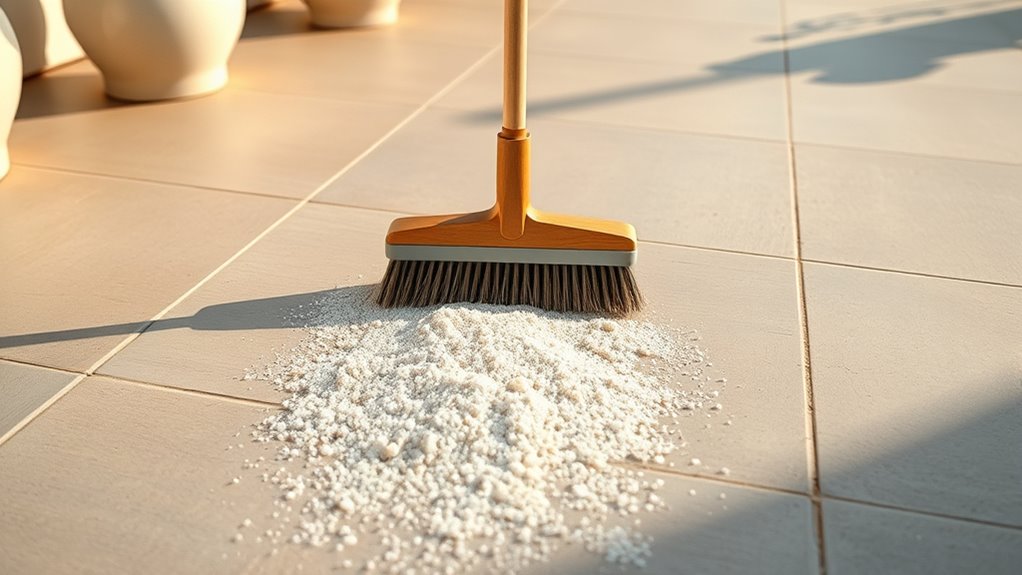To sweep sand and salt off your outdoor patio without scratching, use a broom with soft synthetic bristles and sweep gently in one direction to lift debris without grinding it into the surface. Regularly remove loose buildup, especially after storms, and rinse with water to wash away residual salt and dirt. For stubborn stains, apply a mild cleaner suited to your surface material. Keep your routine consistent to maintain a scratch-free, pristine patio—discover more tips to protect your space.
Key Takeaways
- Use a soft-bristled broom and gentle strokes to prevent scratching delicate patio surfaces.
- Sweep in one consistent direction to lift debris without grinding salt or sand into the material.
- Regularly remove loose debris after storms or snow to avoid buildup and surface damage.
- Rinse the patio with a garden hose to wash away residual salt and dirt, reducing abrasion risk.
- Apply mild cleaning solutions carefully, testing on small areas first to avoid surface damage.

During winter months, sand and salt often accumulate on outdoor patios, creating a gritty and sometimes corrosive buildup. This debris can damage your patio surface if not removed properly, making regular seasonal maintenance essential. To keep your outdoor space looking its best and to prevent long-term damage, establishing a scratch-free sweeping routine is crucial. The first step is choosing the right cleaning tools. Opt for a broom with soft bristles rather than stiff-bristled ones, which can scratch delicate surfaces like tiles, pavers, or concrete. A push broom with synthetic bristles works well because it effectively sweeps away loose debris without causing harm. Additionally, having a dustpan or a leaf scoop helps gather the swept-up material without dragging it back across the surface.
When performing your seasonal maintenance, start by removing loose debris with gentle, deliberate strokes. Sweep in one direction to lift the sand and salt without grinding it into the surface. Avoid using excessive force, as this can cause scratches, especially on softer materials. If you notice stubborn patches of salt or sand, use a softer brush or a specialized patio cleaning tool to loosen debris without damaging the finish. Regular sweeping after storms or heavy snowfall prevents buildup, reducing the risk of corrosion or surface deterioration. Remember, the goal is to keep the surface clean without creating new scratches or grooves that can trap dirt and moisture. Incorporating a routine cleaning schedule during winter months will save you time and effort in the long run. It’s best to sweep at least once a week, especially after snow or icy conditions, to prevent the salt from sticking or causing corrosion. When you’re done sweeping, consider rinsing the surface with water to wash away residual salt and dirt. Use a garden hose with a spray nozzle for controlled water flow, ensuring you don’t dislodge or damage any delicate parts of your patio. For stubborn stains or buildup, a mild cleaning solution designed for outdoor surfaces can help, but always test a small area first to avoid unintended damage. Additionally, understanding surface materials and their specific cleaning needs can help prevent accidental damage during maintenance.
Frequently Asked Questions
How Often Should I Replace My Patio Broom?
You should replace your patio broom every 6 to 12 months, depending on usage and wear. Regular broom maintenance, like cleaning the bristles and checking for damage, helps extend its lifespan. Follow a consistent cleaning schedule to keep it effective for sweeping sand and salt off your outdoor patio. When bristles become frayed or lose their stiffness, it’s time for a new broom to maintain a scratch-free, efficient sweeping routine.
Can Sand and Salt Damage My Patio Surface Over Time?
Sand and salt can gradually damage your patio surface if left unchecked, especially on less durable materials. Over time, these particles act like abrasives, causing scratches and wear that compromise the material’s integrity. To protect your patio, regularly sweep away sand and salt, and consider sealing or choosing durable materials suited for your climate. Proper maintenance helps preserve your patio’s appearance and prolongs its lifespan.
Are There Eco-Friendly Options for Removing Sand and Salt?
Yes, you can opt for eco-friendly solutions to clear sand and salt. Using biodegradable cleaners and natural scrubbing methods makes the process gentle on your patio and kind to the environment. Simply sweep away loose debris first, then gently scrub stubborn spots with a mixture of vinegar and water or a natural cleaner. These options keep your outdoor space beautiful while reducing chemical impact, making maintenance both effective and eco-conscious.
What Tools Are Best for Deep Cleaning Salt Stains?
For deep cleaning salt stains, you should use a stiff-bristled brush or a scrub brush to effectively loosen and remove the residue. Pair this with eco-friendly cleaning solutions like a mixture of vinegar and water or baking soda paste, which are safe and effective. These tools and methods guarantee thorough salt stain removal while keeping your outdoor patio environmentally friendly and free from harsh chemicals.
How Do Weather Changes Affect Salt and Sand Buildup?
Did you know that weather fluctuations can cause a 30% increase in salt and sand buildup on outdoor patios? As temperatures rise and fall, seasonal accumulation worsens because melting snow and ice deposit more salt and sand, which then refreeze or settle. Harsh weather changes, like freezing nights followed by warm days, make debris harder to remove and increase the risk of surface damage. Regular sweeping prevents long-term buildup, keeping your patio pristine.
Conclusion
Don’t let sand and salt ruin your outdoor patio. With a simple, scratch-free sweeping routine, you can keep your space pristine all year round. Some might worry about the effort involved, but regular maintenance actually saves you time and prevents stubborn stains or damage. Plus, you’ll enjoy a cleaner, more inviting outdoor area whenever you want to relax or entertain. A little consistency now means your patio stays beautiful, hassle-free, and ready for any occasion.









